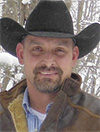Proper fencing layout is a powerful management tool in efficient grazing systems. Livestock protection and confinement are not the only reasons to consider fencing.
An effective rotational or other intensively managed grazing system can be an affordable way to provide forage to grazing livestock and reduce herd nutrition costs year-round.
Fencing needs vary depending on the type of grazing management system and livestock species, class and age.
Determine the operation size, number of animals, type of forage system and number of paddocks needed before investing in fencing materials and supplies.
Many effective fencing options are available to livestock producers. Whether used as permanent or temporary confinements, fences should be carefully planned and constructed for efficient use, long life and low maintenance.
![]() Permanent farm resources
Permanent farm resources
Before planning the layout of a fencing system, evaluate the resources available (Figure 1). Use the information to design a fencing layout that maximizes forage efficiency and provides proper rest periods for plant growth and recovery.
Permanent resources, such as soil type, slope and aspect affect fencing layout plans. Pastures should have similar soil type, slope and aspect to provide uniform forage production and grazing distribution.
Semi-permanent farm resources
Semi-permanent resources include water and shade. Semi-permanent resources are critical for livestock productivity, but can be modified to accommodate the fencing layout.
Water
Fencing layout should be planned to allow livestock access to adequate water supplies. A continuous supply of clean water is essential for all livestock.
Water is a critical nutrient required for a wide variety of body functions in cattle. Adequate, clean water is a key part of rotational grazing systems.
Water quality and accessibility are important in maintaining adequate water intake.
When possible, supply clean water in each paddock within a reasonable walking distance. Otherwise, incorporate into the fencing system a central water source accessible to and within 900 feet of each paddock.
A central water source often produces muddy conditions where livestock congregate. Consider using pipes and portable containers to create mobile water systems and avoid mud.
Any fencing design should allow for flexibility in water placement within paddocks to control animal distribution and avoid trampling around the water source.
If a single water source is used in a particular paddock, make sure it can provide the volume of water needed during peak demand.
When possible, fence off surface water sources, such as creeks and ponds, to prevent livestock from entering water bodies.
Shade
Shade is a major factor to consider when building fences. Shade does not decrease air temperature, but it does reduce animal exposure to the sun’s radiant energy.
Adequate shade can reduce respiration rate and body temperature in livestock during the hottest times of the day.
Shade also alters the grazing habits of cattle. Cattle with access to shade have shown a 3 percent increase in feed efficiency and a 6 percent increase in weight gain during hot weather. There are three types of shade: natural, permanent and portable.
Natural shade is often taken for granted where trees are plentiful. However, take care in situations where only a few trees are growing.
High concentrations of livestock congregating near trees over extended periods of time can kill trees and leave pastures with limited shade.
Establishment of natural shade requires long-term planning that includes protecting trees from livestock-induced damage, particularly during the first years of tree establishment.
Permanent shade can be provided in the form of sheds or barns. These shades can be costly and are not flexible.
Permanent shade structures can become muddy during wet periods and harbor disease-causing agents that can affect livestock production.
For both natural shade and permanent shade structures, consider how shade location changes as sunlight direction changes throughout the day.
Natural or permanent shades along east or west fencelines may provide shade to a particular paddock during only morning or afternoon hours.
Portable shade structures made from galvanized pipe frames can be sturdy enough to withstand livestock activity.
Shades can be moved with cattle as needed or moved to various locations within paddocks to avoid mud and manure buildup. Shades should be 7 to 14 feet tall depending on the species of livestock housed; beef cattle require shades at least 10 feet tall.
Cover shade with shade cloth to allow adequate air movement. At minimum, 400-pound calves require 18 square feet of shade per head, and 800-pound stockers require 25 square feet of shade per head. Provide at least 80 percent of the minimum.
Variable farm resources
Variable resources also play a major role in fencing decisions. A combination of cool- and warm-season grasses, along with compatible legumes, can provide a good forage supply throughout the grazing season.
Use temporary fences to subdivide pastures by grazing method, such as creep grazing or leader-follower grazing, and to separate acreage designated for hay production. Temporary fences are often more economical than permanent fences when small paddocks are needed.
Locations of water, shade and handling facilities are critical to fencing layout. Effective lane systems and gate placement make livestock movement to animal-handling facilities and rotation to other pastures much easier.
Be sure to place gates and passageways for livestock and equipment in the corner of each field closest to the central water source.
Animals should follow through a gate and into a lane system instead of running inside the fenceline when the first animal moves through the gate.
When designing fencing layout, consider legal rights and responsibilities to avoid potential disputes with adjacent landowners. Remember: good fences make good neighbors. FG
References omitted due to space but are available upon request.
—Excerpts from Mississippi State University Extension website

Rocky Lemus
Mississippi State Extension
Extension Forage Specialist
rlemus@ext.msstate.edu










